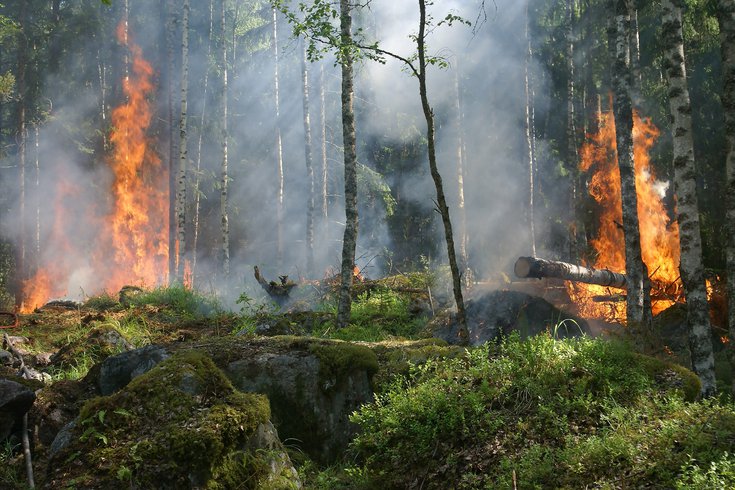
June 02, 2023
 Pixabay/Pexels.com
Pixabay/Pexels.com
Wildfire smoke can lead to a number of health risks during and after events like those in Nova Scotia and New Jersey. There are precautions people can take to reduce pollution inhalation near wildfires and at long distances where their smoke travels.
Smoke from raging wildfires in Nova Scotia and New Jersey has spread to much of the Northeast and Mid-Atlantic over the last week, prompting Pennsylvania and New Jersey to issue air quality warnings.
Hazy skies distant from the wildfires may be easy to overlook since the immediate threat of fire is not present, but exposure to the air could cause short- and long-term health issues.
Wildfire smoke contains a mixture of gases and microscopic particles from the materials consumed by flames, according to the U.S. Centers for Disease Control & Prevention. That includes vegetation, building materials and other matter that may be harmful when burned and carried long distances by the jet stream.
When the National Weather Service issues Code Orange Air Quality Alerts, as happened in much of the Delaware Valley this week, that means air pollution in the atmosphere may be dangerous for sensitive groups. People diagnosed with heart disease, lung disease and asthma are particularly at risk since wildfire smoke can aggravate their conditions.
The most common symptoms from inhaling wildfire smoke are coughing, wheezing, shortness of breath, headaches and stinging eyes. Some people may experience exhaustion, sinus issues and rapid heartbeat.
The CDC says that older people, pregnant women, children and others with respiratory and heart conditions are most likely to feel the effects of wildfire smoke. Even among healthy people, exposure can lead to reduced lung function and inflammation.
The Environmental Protection Agency says particle pollution — the mixture of solid and liquid droplets suspended in the air, also called particulate matter — is the most dangerous component of wildfire smoke. Some of these pollutants are so tiny that they can easily enter indoor settings.
Particle pollution is defined based the on size of the particles, most commonly PM2.5 and PM10. Fine particulates are invisible to the eye but exist within the plumes of smoke and haze seen during wildfires. PM2.5, the main pollutant emitted during wildfires, can be in the atmosphere for a variety of reasons unrelated to a fire, but it tends to be more toxic when spread by wildfires due to the materials that are burned; this is especially true when homes and public infrastructure are destroyed.
The fire in Nova Scotia that started last Sunday tore through about 200 structures, and the smoke from the wildfire reached parts of Massachusetts within a day. The effects of the chemicals released into the air may linger beyond the duration of a wildfire, keeping people at higher risk to experience symptoms even as air quality improves.
In places where wildfires are common, including California and large parts of Canada, research shows that repeated exposure to wildfire smoke increases the risk of developing lung cancer and brain tumors.
“Many of the pollutants emitted by wildfires are known human carcinogens, suggesting that exposure could increase cancer risk in humans,” said Jill Korsiak, a McGill University researcher who studied the long-term effects of wildfires on more than two million Canadians.
There is also growing evidence that short-term and long-term exposure to wildfire smoke can lead to cognitive issues, including "brain fog" and difficulty paying attention, especially among young people.
Due to the emerging scientific evidence on health risks related to wildfire smoke, the EPA has proposed changes to the maximum recommended exposure to PM2.5 and other particulate matter covered by the National Ambient Air Quality Standards.
There are a number of tips people can follow to reduce how much wildfire smoke they inhale.
For those who are high-risk, it's recommended to stay indoors as much as possible during air quality alerts. It's also suggested to keep windows and doors closed and to run an air conditioner if AC is available.
People who are in the immediate vicinity of a wildfire should heed evacuation warnings when they are issued. Paying attention to public health messages and air quality warnings will help guide how much outdoor time should be restricted during these events, even when the wildfires are happening at great distances.
If smoke is clearly visible in the air, it's best to remain inside as much as possible. Keeping an air purifier at home can be useful during wildfires. Masks designed to filter out particulate matter, like N95 masks, are also good to have available.
When exercising, it's best to do so indoors rather than going for a run outside or playing outdoor sports. People inhale air at much higher rates during exercise, which increases the amount of particle pollution taken into the lungs.
Anyone who is concerned about wildfire smoke or experiences troubling symptoms should contact a health care professional. This includes reaching out to ask questions about medications taken for conditions that increase smoke inhalation risks, like asthma and cardiovascular disease.